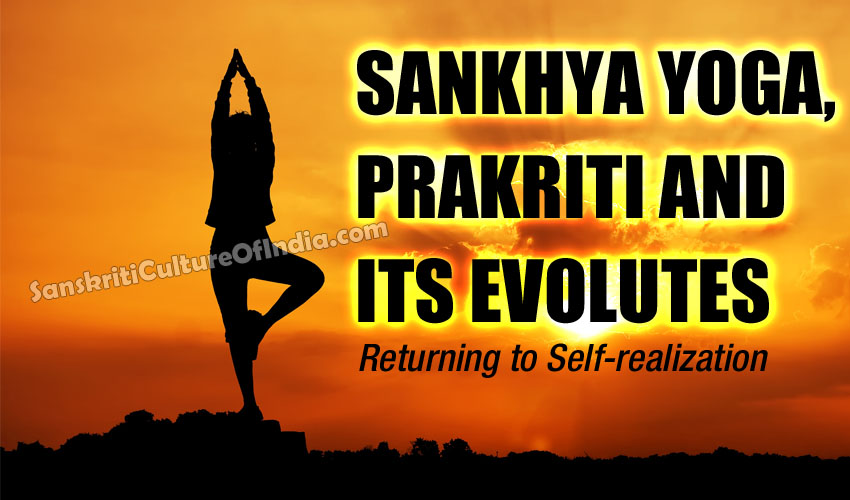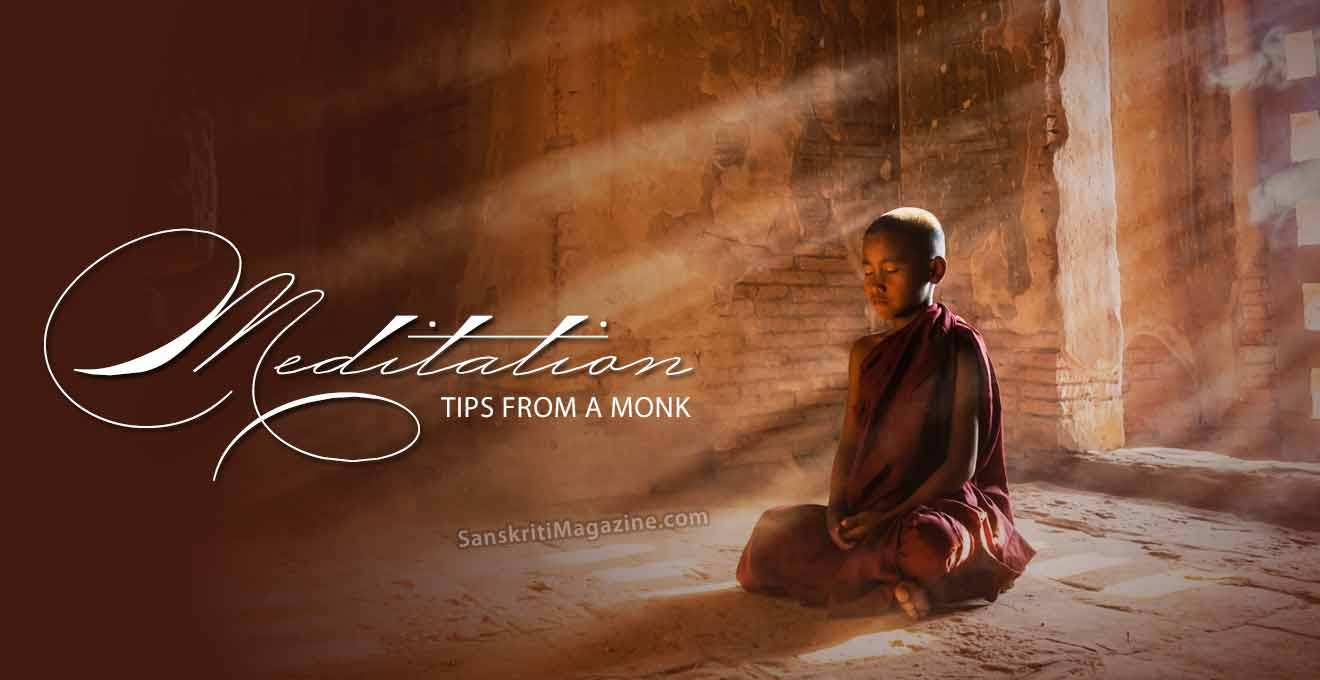Rediscovery of pure consciousness:
The process of Self-realization is one of attention reversing the process of manifestation, of retracing consciousness back through the levels of manifestation to its source. To have a general understanding of this process is extremely useful, if not essential in the practice of Yoga.
You don’t have to know much:
As you read through the descriptions below, please keep in mind that it really does not take a tremendous amount of understanding of these subjects to begin doing the self-awareness and meditation practices.
If you understand the general principle of systematically shifting awareness inward through the evolutes, then the process of meditation can truly be directed towards Self-realization, and not merely relaxation designed for stress management (as useful as that might be). The subtler and subtler practices and insights will come with practice, built on the foundation of simple understanding. With practice, the principles of Purusha and the evolutes of Prakriti become ever more clear.
Real and Unreal:
Sankhya philosophy views anything that is subject to change, death, decay or decomposition as being “unreal” rather than “real.” This does not mean that the objects are not there in front of you. Rather, they are not ultimately “real” in that their form keeps morphing from this to that to the other. What is considered “real” is that final substratum which never changes, cannot die, and cannot possibly decay or decompose. It is the direct experience of that “absolute reality” which is being sought.
Something evolves out of something:
Ornaments can be said to evolve out of metal. Pots can be said to evolve out of clay. Our world is filled with objects. Objects are made of compounds. Compounds are made of molecules. Molecules are made of atoms. Atoms are made of particles. Particles are made of a subtler substratum. While one evolves out of the other, all of these levels of reality coexist and interact with one another.
Humans are also multi-leveled:
So too, is the construction of the human being. We are multi-leveled beings, with the next level emerging out of the previous, while those levels still coexist and interact with one another (see the charts). While the human is made of physical material, we are also constructed of subtler levels of reality, which are products of the unmanifest, primordial essence called Prakriti in Sanskrit.
Familiar human evolutes:
We are all familiar with the process by which our quiet mind has a memory arise, which triggers emotions, causing chains of thoughts to emerge from that, and to then further emerge into actions and speech. Each of these is a process of one level of functioning emerging or evolving out of the previous, while each of those levels still exists on its own.
In this way, the actions and speech (which emerged from mind) still coexist with the whole of the conscious mind, as well as with the whole domain of the unconscious mind, and also with the still, silent center of pure consciousness (whatever we might call this consciousness, or however we might individually perceive it). All of these coexist, while one leads to the next, with the grosser emerging from the subtler. So it is with all the levels of Prakriti.
Evolutes of Prakriti:
Similarly, our whole being, in the spiritual sense, is multi-leveled, with the next stage emerging or evolving from the previous. This is the subject of Prakriti, which can be loosely described as unmanifest, primordial matter (which is subtler than the gross realm of quantum physics). This Prakriti (“matter”) is infused with pure consciousness, which is called Purusha. Here, however, we are not just talking about the evolutes of chains of thought and emotions, but also the evolutes of the instruments by which we think and emote. This is taking us to the core of our being.
Experiencing consciousness alone:
Yoga has been described as a process of realizing the direct experience of consciousness (Purusha) as independent of all levels of false identity (manifestations of Prakriti). These false identities are all seen as evolutes of the primordial stuff or matter (Prakriti) from which they emerge. Purusha (consciousness) is actually at all times independent of the interplay, but has become falsely identified with all of this.
Retracing our way back:
The reason this is important is that the process of enlightenment (or awakening) is one of reversing the process, of tracing our way back through the stages of evolutes. The chart above shows the evolutes, and the chart below shows the journey of tracing our way back to consciousness alone, which is the meditation process of systematically withdrawing consciousness from the evolutes.
Sankhya-Yoga:
What we now call “Yoga” or “Raja Yoga” has also been called “Sankhya-Yoga,” since the practical Yoga methods rest on the philosophical foundation of Sankhya, which is represented in the chart above. This is a widely held view of the relationship between Sankhya and Yoga. Some may not agree with this perspective, but that is a matter for the scholars to debate. Sankhya is thus the foundation for the Yoga described by Patanjali in the Yoga Sutras.
To debate or not debate:
Some intellectuals will also debate furiously and endlessly about whether the ultimate nature of reality is dualistic or non-dualistic. Some will say that Purusha (as consciousness) and Prakriti (as matter) are eternally separate, and therefore, ultimate reality is dualistic. Others will argue that the two are ultimately seen to be one and the same, and ultimate reality is non-dualistic. However, the seeker of direct experience through the practices of Yoga need not enter these debates intensely. While there may be some value in reflecting on these principles, and maybe even forming a provisional opinion, what is far more important is to understand and actually do the practices.
This is very practical:
Here, in this article, the evolutes of Prakriti are being presented as practical information for the modern seeker who is not a scholar or philosopher, but is a seeker trying to gain a basic understanding that will facilitate personal meditation practices. By having a working knowledge of the evolutes of Prakriti, the journey of moving attention in the reverse direction (involution) makes much more sense.
Universal principles: It is most important to note that the principles here are also contained in many other systems, although they may not be explained or used in precisely the same way. For example, the concepts of mind and senses, gross and subtle elements, and ego and intelligence, are universal principles. These are also included, for example, in Vedanta and Tantra as well, and also many other traditions. This is not said to force all of the many traditions into one box, but to help allow us to seek and see the underlying reality that is trying to be explained and reached through the practical application of the practices.
Uncovering false identities:
The practices have to do with systematically uncovering the many false identities we have taken on by Purusha (consciousness) commingling with Prakriti (matter). By starting with the gross levels of these false identities, and gradually discerning deeper and deeper, our true nature will ultimately be revealed through direct experience.
Descriptions of the Evolutes of Prakriti:
Following are some brief descriptions of the evolutes of Prakriti, which are in the two tables shown in this article. The most important principles are that of Purusha and Prakriti, which are consciousness and primordial matter. Everything else emerges from Prakriti, and then is infused with Purusha. So, for example, all the levels of manifestation of the human (gross and subtle) are Prakriti, but have life due to the infusion of Purusha. One of the easiest ways to grasp this process of evolving and infusing, as well as arising from and receding into Prakriti, is to scroll down and read about the way the senses operate. The other evolutes arise and recede in a similar way.
Purusha:
Of the two companion principles, Purusha is consciousness that is untainted, ever-pure. It is self-existent, standing alone from other identities of individuality; conscious being-ness; the principle of spiritual energy.
Prakriti:
The other of the two companion principles, Prakriti is the unconscious, unmanifest, subtlest of the material aspect of energy. It is the primordial state of matter, even prior to matter as we know it in the physical sense. Prakriti manifests as the three gunas and the other evolutes.
Mahat or Buddhi:
This is the purest, finest spark of individuation of Prakriti (primordial matter). It is very first of the evolutes of Prakriti. It is individuation, but yet, without characteristics. Buddhi is the word, which applies to the individual person, while mahat refers to the universal aspect of this process.
Ahamkara:
This is the process of ego, by which consciousness can start to (incorrectly) take on false identities. Here, the word ego is used not to mean the actual qualities such brother or sister, or loving or cruel, but the capacity itself to take on the countless identities. (See Two Egos section of Four Functions of Mind)
Gunas:
Prakriti (primordial “matter”) has three characteristics or attributes of lightness (sattvas), activity (rajas), and stability (tamas). These three combine and re-combine so as to form the various aspects of mind, senses, and the five elements: earth, water, fire, air, and space.
Mind:
Mind (manas) is the instrument, which is the driving force behind actions, speech, and the thinking process. It is also the recipient of the sensory input. It is useful to know that, here, mind is being used in this more limited way, rather than the whole of the inner process called antahkarana, which includes manas, ahamkara, buddhi, chitta, along with the senses and the five elements.
Senses/Instruments:
The five senses and five instruments of expression are like ten doors of a building. Five are entrance doors, and five are exit doors. These ten indriyas are evolutes of mind.
One way to understand this process of the senses being evolutes of mind is to notice what happens when you fall asleep, into dreamless sleep. What happens to your senses, your ability to perceive through those senses? They seem to go away, yet they return after sleep. Where did they go? It is in that sense that we might say the senses are still there, but that they have receded back into the field of mind from which they arose in the first place.
This same process of arising and receding happens not only with the senses, but all of the evolutes of Prakriti.
Also, if the senses arise from and recede into the field of mind, then it is also easy to see that during times when the senses are operating, they are also infused with mind, the next subtler level of Prakriti. In other words, senses without mind operating through them simply do not work. The idea of senses operating without mind infusing them seems rather silly, in fact. It is that simplicity that is in the whole concept of Prakriti manifesting outward, and the process of meditation retracing that process inward.
Elements:
A further outpouring of Prakriti is when it bursts forth as the equivalent of space, as experienced in the subtle (non-physical) realm. From, and within that emerges air (thinness, lightness, airiness), then fire (energy), then water (flow, fluidity), then earth (solidity, form). When these five elements are in the subtle realm, they are known as tanmatras. When they further come outward, manifesting into the physical world, they are known as bhutas. From these, all of the many objects of the external world are composed.
Senses experiencing the Elements:
Notice that the Senses and Instruments of action (Indriyas) emerge out of unmanifest matter, or Prakriti. Notice that the five Elements also emerge out of Prakriti. Thus, one set of evolutes (Senses and Instruments of action) are relating to another set of evolutes (the five Elements in the form of many objects). This is one way of explaining the mechanics of how it can be that all is one can appear to be multiplicity.
~ by Swami Jnaneshvara Bharati











